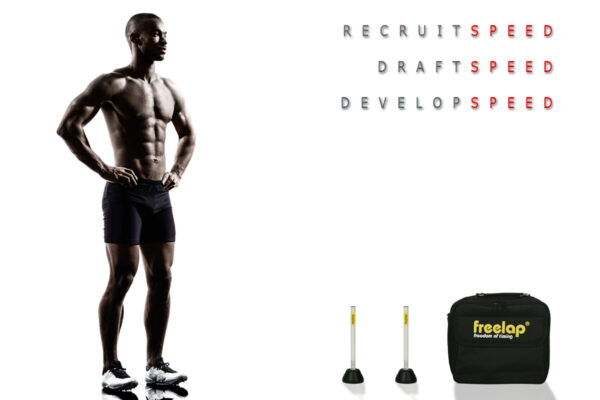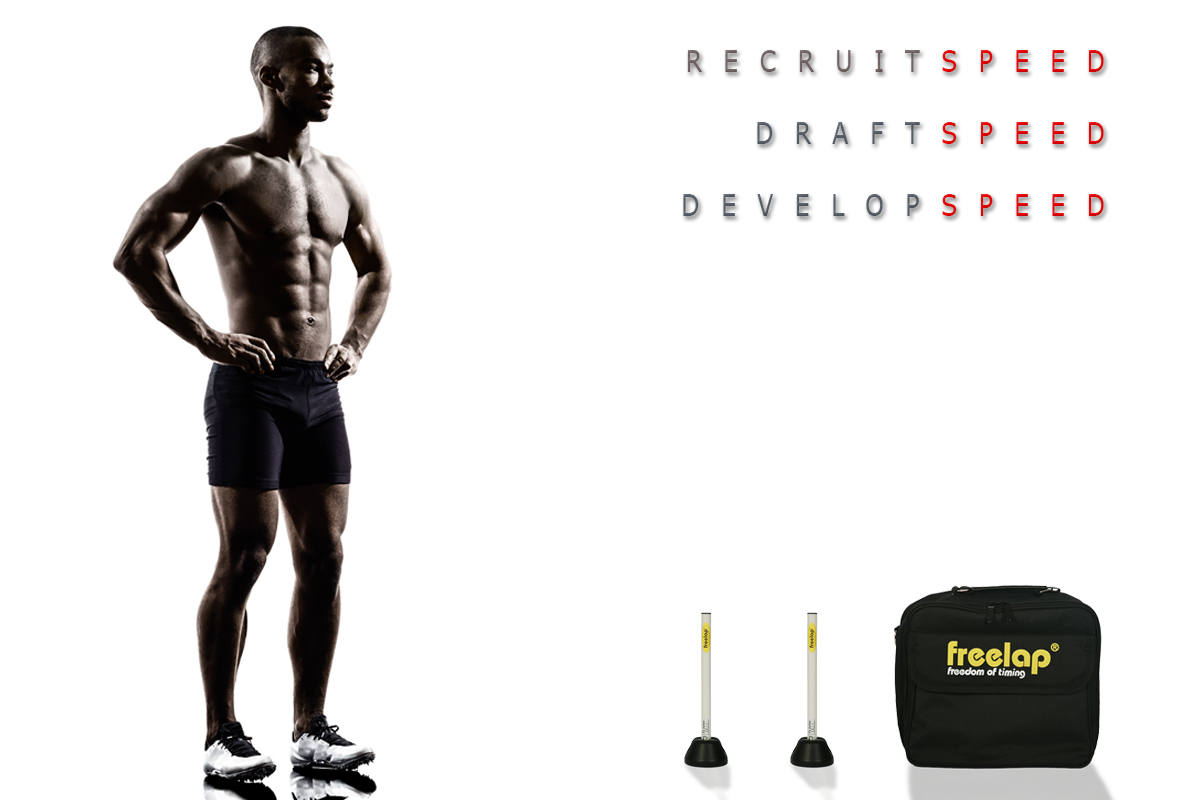
By Carl Valle
A frequently asked question is how fast athletes in sports apart from track and field, where the precision of timing is well established, really are. Other vitals, such as height and weight, are readily accepted, but benchmarks on speed in field sports are viewed with skepticism given the problems with timing accuracy and achieving common-ground testing.
Speed, that most valuable of biomotor skills, seems amazingly to be least evaluated properly or even at all in field sports. Many Americans in their 30s will remember the 50-yard dash as a key test for earning the patch and award. After failing for years to hit above the 85% standard on speed, the author made the cut in his final semester in high school, likely from the benefits of being manually timed with a stopwatch on a very hot spring day.

Today, such standardized testing is largely gone. Fitness is less performance and more wellness based, leaving parents wondering just how fast their children are.
NFL teams, meanwhile, are still timing the 40-yard dash as a benchmark of speed, including with veterans as a way to screen for continued ability to play in the league. When we hear that someone has lost a step, the reference is not to a dancing flaw but, rather, to the slowing of an athlete with age—a sure sign that father time has caught up to that athlete.
Evaluating speed is important from the early to the latter years of life. Equally vital is what can be done to help people of all ages improve their speed and achieve acceptable or better evaluation results.
That we prioritize speed is irrefutable. From even the earliest years of a child’s life—too early, in fact—we see impatient parents coaxing the child to walk before the child is ready. After the child is walking, parents encourage running. And then come indirect ways of appraising speed, starting with scavenger hunts that are first come first reward. Every Easter, for instance, many families celebrate with an Easter egg hunt, a child’s first organized combine.
Later, a child’s selection for neighborhood pickup games and then organized sports teams hinges on speed. Team captains usually pick the fastest kids first, as these are typically the best athletes. Speed is of premium value as a competitive advantage in even our earliest sporting endeavors.
With each passing year, child athletes face growing competition for finite roster space. Teams represent entire schools, and the degree of competitiveness for berths on school teams is most acute when age groups are replaced by grade levels.
Around middle school, things become especially tricky as biological and chronological ages blur amid a flush of hormones and highly individualized development. A mature-looking 13-year-old boy who started kindergarten late will appear at a glance to have a grossly unfair physical advantage while playing against comparatively undeveloped 12-year-old boys.
Eventually, time will cancel out the hormonal advantages, so coaches are advised simply to focus all the while on coaching and training and not the fleeting benefits of testosterone-fueled growth spurts. Sports scientists have known for years that chronological age (birthdate) and biological age (where an individual is developmentally) matter when interpreting speed and power and that it is key with this data to always have a long-term perspective. It’s not that the performance of youth athletes shouldn’t be assessed—this is a great way to track development—but, rather, that evaluations of youngsters be viewed with an eye on the future and not seen as definitive measures of the presence or absence of potential.
As youth athletes in especially team sports enter high school they often are struck by the harsh realities of competition and selection. A superbly talented youth may make a varsity team and a subpar athlete ride the bench of the freshman team. On the other hand, a junior who is the best in his or her league in Vermont may only get letters from division III schools, while a lowly ranked Texas kid may get a full-ride offer from a small division I institution.
Track and field is far less subjective than many sports, and scouting, including online scouting, is primarily a simple aggregating of performance times or distances. There is no hiding the truth in the speed events, for instance; the winners of races generally are the fastest and most deserving of selection. But even here selection can have nearly as much to do with geography as timing. An average high school relay team in Florida just might be running times that would make it a state champion in Rhode Island. Timing makes things crystal clear, especially when wind readings ensure that performances are not assisted, so it’s highly likely that it’s the kids from Florida who will be hearing from the big postsecondary institutions.
By the time young athletes are juniors in high school, they’ve pretty much been evaluated and had their fate in postsecondary sport decided. Some late bloomers may surface, but the painful reality is that most talent has been determined before high school graduation. We all love the underdog stories, but they are popular for good reason. Athletes who emerge out of nowhere to fight for berths are so rare that they make compelling reading or viewing.
Regardless of how they make it into postsecondary athletics, young adult athletes face increasingly demanding training because they are nearing their biological and, more, their genetic limits. Unlike in grade school, where gains in strength and speed happen quickly and easily, in the collegiate athletic environment young adult athletes experience plateaus in performance. The smallest margins of improvement are therefore highly valued and ardently sought, particularly as athletes move into elite sports where mere fractions of a second separate winners from losers. Speed and power are typically the determinants.
At the elite level, much of the effort in coaching and training focuses on ensuring that the athlete is ready rather than better. Most team sports in particular are about optimizing versus maximizing. This is true even in elite sprinting. Amid goals by coaches and athletes to do things better, to seek access to ever more favorable opportunities and conditions, and to achieve marginal gains up to 1%, most efforts are on keeping athletes healthy. Elite athletes have done the work; the key is sustaining speed and power output versus increasing it, in large part through quality methods of injury prevention and management.
There comes a time, though, when every elite athlete must face mortality and call it quits. Athletes the likes of Barry Sanders have done well to walk away at the top of their game. Others, such as Bo Jackson, are forced to leave the field of play too early because of injuries. At the opposite end of the spectrum are athletes who depart the playing field painfully too late, competing to the end as sad shadows of their former selves. Power and speed diminish over time, largely as a result of hormonal changes. Eventually, athletes slow down and lose their ability to handle the force of gravity.
Developing the Right Perspective
Establishing a healthy, long-term viewpoint on developing and maintaining speed calls for an emphasis on the four T’s: teaching, training, testing, and tracking. These four considerations, provided they are applied as a whole, offer the balance needed in any evaluation process. It’s easy to get lost and focus on only one area, such as training, and to forget that sometimes a one-on-one teaching session can save weeks of training by repairing, for example, an athlete’s deficiency in gross motor skills.
Teaching. Good instruction is paramount throughout an athlete’s career, but particularly in the early development stages. Give a child competency in locomotion, and more specific skills can be easily added. Running is the cornerstone for most sports, and having general speed will always transfer from sport to sport and allow ready acquisition of sound sport skills. No guarantee exists, of course, that being fast will propel a youngster into the stratosphere of elite sport, but a general lack of speed is a certain guarantee of failure at any sporting level.
Training. Down the road, increasing the volume and intensity of training is necessary to overload the body for greater displays of speed and power and the cultivation of higher-level skills. Heavy training is a risk, but not partaking is likewise a risk. A balance of technical instruction and intensity and volume will result in benefits. Too much competition, however, limits training time and jeopardizes long-term athlete development.
Testing. Accurate timing is essential to objectively evaluating how fast an athlete can move linearly and laterally. Video is important to record contextual ability, but recording raw speed is a great way to see an athlete’s potential for creating or closing space in games. Any program claiming to develop speed needs to determine if it is doing so well or at least better than the established norms.
Tracking. Athletes’ speed development should be tracked over time to determine if progress is being made or if stagnation has set in. Periodic regressions may result merely from fatigue, which is why athletes need to be tested continuously to see if positive change is occurring beyond the occasional, easily explainable setback. If an athlete’s speed plateaus, interpreting tracking data must address what could improve or change to effect desired outcomes. Sometimes, an athlete can attain a higher level of conditioning than previously yet still see a drop-off or stagnation in speed. Tracking is the key to learning why the athlete is gaining, maintaining, or loosing speed.
Speed is not a mystery when it’s evaluated and interpreted appropriately. When NFL combine preparation centers tout amazing improvements in speed, the questions to be asked include was that speed developed through sound conditioning and full-time training or are the centers merely profiting from having a pool of already supremely fast talent?
Likewise, are high school athletes getting faster merely because of the natural maturation process or as a result of excellent instruction in running form? Are college athletes improving because of smart training and good nutritional habits, or is it simply a loss of fat that has contributed to their getting more explosive?
The only way to know is to measure the most coveted of athletic qualities: speed.
Please share this article so others may benefit.
[mashshare]


